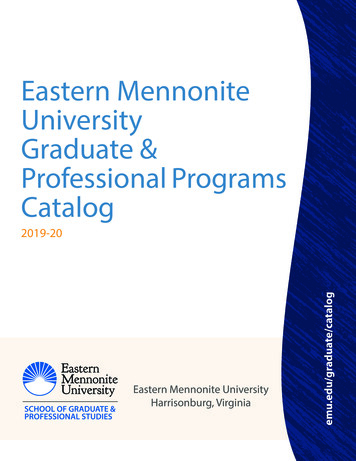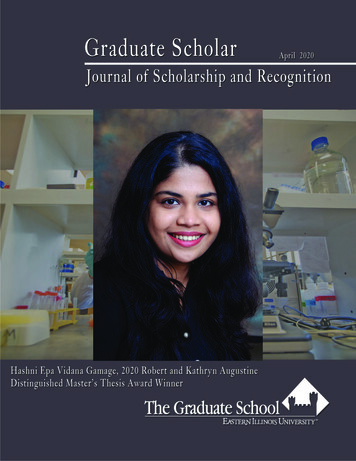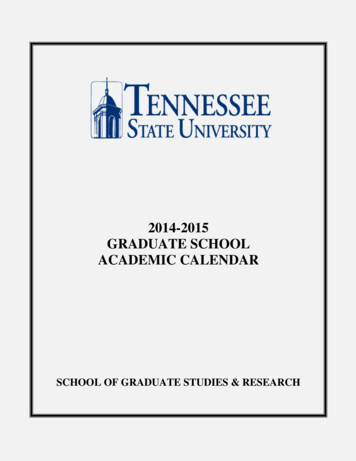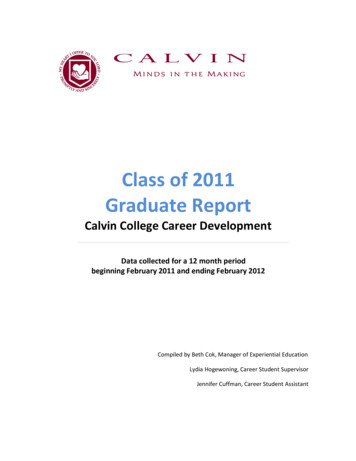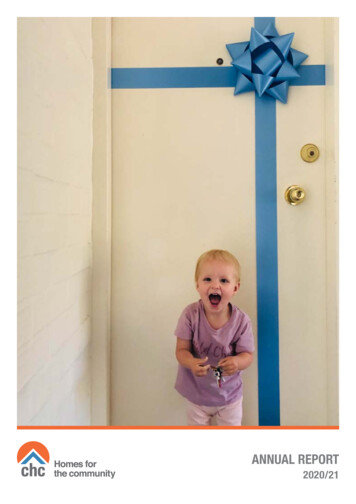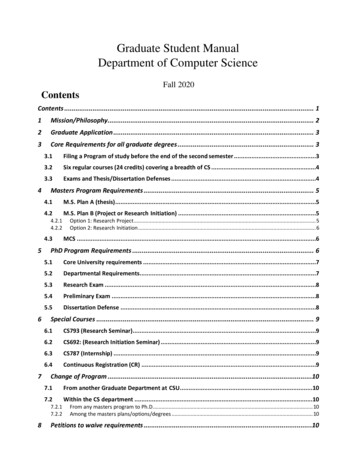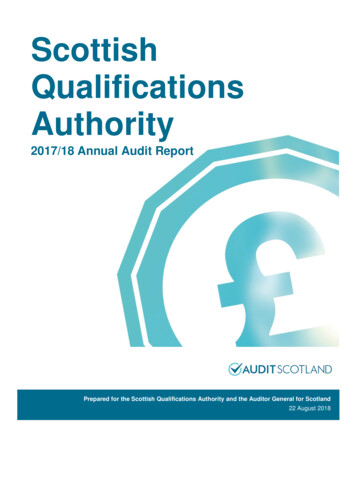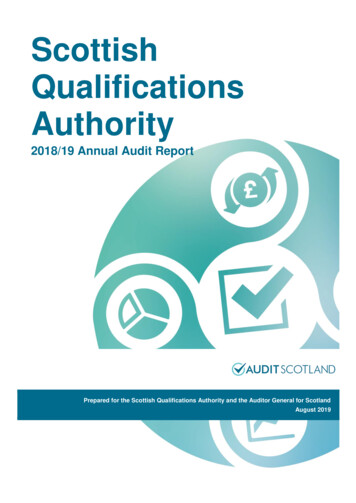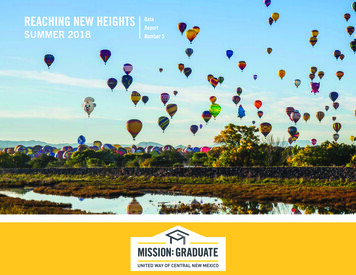
Transcription
DATA REPORT NO. 05ANNUAL DATA REPORT MISSION: GRADUATEWe are pleased to bring you Reaching New Heights, our fifth annual data report.Our education partners have made great progress. We can announce that20,226 NEW degree and certificate graduates have been added to centralNew Mexico since 2010. This represents the number of new graduates aboveexpected projections from baseline year 2010.We are now more than a third of the way towards our ambitious goal of 60,000new graduates with certificates and degrees by 2020.We are also pleased to share that our partnership continues to grow. With 353individual partners representing 149 organizations, we are singularly focused onscaling our work to achieve greater impact.This past year, we grew our Vision Council to 23 members. With their influenceand support, we are reaching new heights.We are strengthening our community foundation by focusing on early literacyand early childhood supports. We are working with high schools to improveattendance and engagement and college and career readiness. We are alsotargeting goals for college enrollment and career development.Read through to learn more about the reach and impact that we have made thisyear. Give us your thoughts and join our effort. Together, we can work towardbetter outcomes for our community.Kirby JeffersonVision Council Co-ChairRaquel ReedyVision Council Co-Chair
DATA REPORT NO. 05ANNUAL DATA REPORT MISSION: GRADUATE2018 PRIORITIESFOUNDATIONAL2020 GOAL-ORIENTEDKindergarten Readiness & Early Grade ReadingEarlyLiteracyEarly ChildhoodFamily SupportsSummerLearningHigh School GraduationAttendance arly dAttendanceImprovementHealthLeadershipHigh SchoolConnections CapacityLaunchto LearnTeacherSupportCollege &Career ReadinessAdult Transitionsto CollegeSouth Valley CareerExplorationDemonstrationRio RanchoSummer TeacherAcademyAttendancePolicy &PracticeEMPLOYER ENGAGEMENTCollege Enrollment & CompletionValencia CountyCareer ExplorationGraduate! ABQCareer-Based Learningin Higher EducationDATA & RESEARCHCOMMUNICATIONS01
DATA REPORT NO. 05ANNUAL DATA REPORT MISSION: GRADUATEABOUT MISSION: GRADUATEWhy Mission: Graduate1Career Success. A growing numberof jobs require postsecondaryeducation. By 2020, 63 percent of NewMexico’s jobs will require more than a highschool diploma.12Economic and Family Stability.In New Mexico, adults with anassociate degree are four percent morelikely to be employed and also earn 10,000 a year more on average thanthose with a high school diploma.2The vast majority of jobs that have beenadded to the economy during the recoveryfrom the recent Great Recession requirecollege credentials. This trend is unlikelyto change.3Nationally, communities with higheducational attainment are also showingstrong economic growth.4 Sixty thousandnew graduates with economic stabilityin central New Mexico can help familiesbreak the cycle of poverty and ensure betterhealth and education for their children.3Community Well-Being. Educationis critical to social and economicdevelopment and has an impact oncommunity health. Higher levels of education areassociated with a range of positive communityhealth benefits – including better health andwell-being, greater community engagement, andsocial/cultural equality in access to resources.5Percent of Population with an Associate Degree or Higher60,000 new graduateswill enhance thepreparedness of ourworkforce and thewell-being of ourcommunity.Source: American Community Survey 2011-2015, 5-Year Estimates123402Carnevale, A. P., Smith, N., & Strohl, J. (2013). Recovery: Projections and Education Requirements Through 2020: State Report. Washington: Georgetown University Center on Education and the Workforce.American Community Survey (ACS) Microdata, 2011-2015, 5-Year EstimatesCarnevale, A. P., Jayasundera, T., & Gulish, A. (2016). America’s Divided Recovery: College Haves and Have-Nots. Washington: Georgetown University Center on Education and the Workforce.Shearer, R., Friedhoff, A., Shah, I., & Berube, A. (2017). Metro Monitor: An index of inclusive economic growth in the 100 largest U.S. metropolitan areas. Washington: Brookings.
DATA REPORT NO. 05ANNUAL DATA REPORT MISSION: 112,716WAOSTTGETARGRD4,496201020152020What Do the Data Tell UsHow Does ABQ CompareAs of 2016, the most recent year for which we have data,educational attainment in central New Mexico is up 20,226new graduates compared to our 2010 baseline.6Nationally, communities with particularly robust economicgrowth in recent years are not only ahead of us, but theireducational attainment rates have also grown faster thanours since 2010.Our community can be proud of the achievements of our localcolleges and universities and of our graduates. If we are tomeet the big goal set by Mission: Graduate’s Vision Council –60,000 by 2020 – accelerating our progress is essential.NEW GRADUATESSINCE 20102,577 CERTIFICATE GRADUATES17,649 DEGREE GRADUATESNEW ADDITIONAL graduates withdegrees and certificates (2010-2016)TOTALdegrees /certificatessince the year 2010.56Zimmerman, E.B., Woolf, S.H., & Haley, A. (2015). Understanding the relationship between education and health: A review of the evidence and an examination of community perspectives. Rockville, MD: Agency for Healthcare Research and Quality.We calculate progress toward the goal using two data sources. For degree graduates: We use ACS 5-Year estimates to calculate the increase since 2010 in adults 18 and over with at least an associate degree, adjusting for population growth. Forcertificate graduates: We use data from the Integrated Postsecondary Education Data System (IPEDS) to calculate the increase since the 2010-11 school year in adults 18 and over earning a postsecondary certificate, adjusting for population growth.03
DATA REPORT NO. 05ANNUAL DATA REPORT MISSION: GRADUATE3rd Grade ReadingPercent of Students at ProficiencyThe opportunity gap is the disparityin access to quality schools andresources needed for all children tobe successful. In central New Mexico,a child’s chances of success areimpacted by an opportunity gap thathas African American, Hispanic andNative American communities faringworse on average than their White andAsian peers. Mission: Graduate seeksto close these gaps and annuallyprepares this Opportunity Scorecardto track progress toward this it our Seven Core OutcomesInteractive 15.4%2015-162016-17ASIANWHITEBLACK / AFRICAN AMERICANHISPANIC OR LATINONATIVE AMERICAN*Key applies to both pagesPercent of Students at Proficiency8th Grade 014-1511.8%2015-162016-17Source: NM Public Education, 2016-17 PARCC; Proficiency is definedas Accomplished and Above04
DATA REPORT NO. 05ANNUAL DATA REPORT MISSION: GRADUATEHigh School Completion96.0%91.8%89.4%Percent of Males25 Years or OlderPercent of Females25 Years or ce: American Community Survey, 5-Year EstimatesPercent of High School StudentsWho Enroll in Postsecondarywithin 16 Months of GraduationPost-High School College 64.5%48.5%20112012201320142015Source: NM Public Education DepartmentCollege Attending %73.8%Percent of Males25 Years or OlderPercent of Females25 Years or 201420152016Source: American Community Survey, 5-Year Estimates*Individuals who attended but did not necessarily complete college05
DATA REPORT NO. 05ANNUAL DATA REPORT MISSION: GRADUATEEARLY GRADE LITERACYMIDDLE GRADE MATHHIGH SCHOOL GRADUATIONPercentage ofchildren who are“accomplished andabove” in key domainsat the beginning ofkindergartenPercentage of thirdgraders who meet orexceed expectationsin English LanguageArts / LiteracyPercentage of eighthgraders who meet orexceed expectationsin MathPercentage of highschool studentswho graduate withinfour years 5.3% 10%RATE OF CHANGEMission: Graduate tracksdata on seven coreoutcomes that paint a broadpicture of how central NewMexico is faring.7 With ourpartners, we selected theseoutcomes as measuresof our collective progresstoward shared results.This scorecard providesa 10,000-foot view of ourcommunity’s progress onMission: Graduate’s sevenoutcomes compared witha baseline year. Baselineyears differ by outcome dueto changes in assessmentsand data availability.KINDERGARTEN READINESS .6%5%BASELINE-5%-10%YEARLY AVERAGEPERCENTAGE-8.6%DATA NOTCURRENTAVAILABLEDATA NOTBASELINEAVAILABLE725.5%IN 2016-1730.8%IN 2014-1522.0%IN 2016-1719.9%IN 2014-1568.5%IN 2016-1764.5%IN 2010-11Four-county data include, where applicable, the following school districts: Albuquerque Public Schools, Belen Consolidated Schools, Bernalillo Public Schools, Estancia MunicipalSchools, Los Lunas Schools, Moriarty-Edgewood Schools, Mountainair Public Schools, Rio Rancho Public Schools, and state charters in the Albuquerque area; and where applicable,the following higher education institutions: Central New Mexico Community College, University of New Mexico-Main Campus, University of New Mexico-Valencia County Campus,06
DATA REPORT NO. 05ANNUAL DATA REPORT MISSION: GRADUATECOLLEGE ENROLLMENTPercentage of highschool studentswho enroll in postsecondary educationat any time within 16months of graduationCOLLEGE COMPLETIONNumber of parttime and full-timeundergraduatesenrolled in the fallNumber of degreesand certificates,all levels, awardedby postsecondaryinstitutions in centralNew MexicoPOST-COLLEGE EMPLOYMENTPercentage of firsttime, full-timedegree or certificateseeking studentswho graduate within150 percent ofnormal timePercentage ofcentral New Mexicopostsecondarygraduates employedat one-year postgraduation (CNMand UNM only) 6.5% .8% 2.9%BASELINE-0.9%-3.8%67.7%OF 2015 HS GRADUATES70.6%OF 2011 HS GRADUATES51,633FALL 201663,649FALL 201114,934IN 2016-1710,878IN 2010-1138.3%IN 2016-1736.6%IN 2010-1176.2%IN 2015-16**Data notcurrently availablefor 2016-201773.3%IN 2010-11Southwestern Indian Polytechnic Institute, Aveda Institute-New Mexico, Brookline College-Albuquerque, Brown Mackie College-Albuquerque, Carrington College-Albuquerque, De Wolff College Hair Styling and Cosmetology,ITT Technical Institute-Albuquerque, National American University-Albuquerque, National American University-Albuquerque West, Pima Medical Institute-Albuquerque, Pima Medical Institute-Albuquerque West, SouthwestAcupuncture College-Albuquerque, Southwest University of Visual Arts-Albuquerque, Toni & Guy Hairdressing Academy-Albuquerque, Universal Therapeutic Massage Institute, University of Phoenix-New Mexico.07
DATA REPORT NO. 05ANNUAL DATA REPORT MISSION: GRADUATESTRENGTHENING THE PIPELINE TOWARDSCOLLEGE ENROLLMENT AND COMPLETIONThe best way to improve high school graduation rates and college enrollment is to ensure that we have a healthy educational pipeline, beginningat birth and continuing through a child’s school years. However, many central New Mexico students are struggling in core subjects, such asreading, math, and science. In 2016, fewer than 35 percent of 3rd grade students in the four-county region were proficient in reading. Similarly,fewer than 43 percent of 8th grade students were proficient in math. It is clear that there is significant room for improvement in the early learningoutcomes of our students.8th Grade Math Proficiency3rd Grade Reading Proficiency23%ALBUQUERQUE PUBLIC SCHOOLSBELEN CONSOLIDATED SCHOOLS22%BELEN CONSOLIDATED SCHOOLSBERNALILLO PUBLIC SCHOOLS21%BERNALILLO PUBLIC SCHOOLSALBUQUERQUE PUBLIC SCHOOLSESTANCIA MUNICIPAL SCHOOLS19%10%9%43%ESTANCIA MUNICIPAL SCHOOLS33%LOS LUNAS SCHOOLS32%LOS LUNAS SCHOOLS22%MORIARTY-EDGEWOOD SCHOOLS32%MORIARTY-EDGEWOOD SCHOOLS20%MOUNTAINAIR PUBLIC SCHOOLS30%MOUNTAINAIR PUBLIC SCHOOLSRIO RANCHO PUBLIC SCHOOLS34%RIO RANCHO PUBLIC SCHOOLSSTATE CHARTER SCHOOLS32%STATE CHARTER SCHOOLS24%39%27%Source: NM Public Education Department, PARCC, 2017Source: NM Public Education Department, PARCC, 2017Additionally, many central New Mexico high school students are not graduating within four years, and all of our four county school districts havegraduation rates below the national average of 84 percent.High School Graduation RatesALBUQUERQUE PUBLIC SCHOOLS67.9%BELEN CONSOLIDATED SCHOOLS68.9%BERNALILLO PUBLIC SCHOOLS56.8%80.1%ESTANCIA MUNICIPAL SCHOOLSLOS LUNAS SCHOOLS76.3%MORIARTY-EDGEWOOD SCHOOLS77.6%MOUNTAINAIR PUBLIC SCHOOLS60.7%RIO RANCHO PUBLIC SCHOOLSSTATE CHARTERS IN CENTRAL NM0882.0%55.7%Source: NM Public Education Department,2016-17 Four-Year Graduation Rates
DATA REPORT NO. 05ANNUAL DATA REPORT MISSION: GRADUATEChronic AbsenteeismAbsence Rates by Race/EthnicityAMERICAN INDIAN OR ALASKA NATIVEHISPANICBLACKWHITE34.6%One potential factorimpacting our high schoolgraduation rate is chronicabsenteeism—which isdefined by the federalgovernment as missing 15or more days in the schoolyear, for any reason.On average, 21.8 percentof central New Mexicostudents were identified aschronically absent duringthe 2015-16 school year.22.9%ALBUQUERQUE PUBLIC SCHOOLS29.4%16.8%23.0%15.6%BELEN CONSOLIDATED SCHOOLS26.0%16.1%27.2%19.4%BERNALILLO PUBLIC SCHOOLS22.2%16.3%50.0%22.1%ESTANCIA MUNICIPAL SCHOOLS12.5%22.5%24.1%20.0%LOS LUNAS SCHOOLS24.1%18.6%5.1%21.0%MORIARTY-EDGEWOOD SCHOOLSMOUNTAINAIR PUBLIC SCHOOLSThrough research oneffective practices and asustained, open dialogueRIO RANCHO PUBLIC SCHOOLSwith our communitypartners, Mission: GraduateSTATE CHARTERS IN CENTRAL NMhas developed a set ofstrategies, describedin the next section, thathave the potential tosignificantly increase high school graduation rates.These strategies include early literacy, early childhoodfamily supports, summer learning, attendance andengagement, and teacher .8%8.5%18.5%10.7%9.4%Source: U.S. Department of Education, Civil Rights Data Collection, 201509
DATA REPORT NO. 05ANNUAL DATA REPORT MISSION: GRADUATEReaching beyond high school, Mission: Graduate also supports initiatives to increase college enrollment and completion with a focus on collegeand career readiness and adult transitions to college. By 2020, 63 percent of jobs in the four-county region will require a college degree orcertificate. While some institutions of higher education, most notably the University of New Mexico and Central New Mexico Community College,are reporting increased certificate and degree completion, we are seeing a troubling long-term trend of decreased access to all institutions ofhigher education.Number of Part-time and Full-time UndergraduatesEnrolled During the Fall 008,0006,00020,00010,000Number of Degrees and Certificates Awarded byPostsecondary Institutions in Central New Mexico4,00020112012201320142015Source: Integrated Postsecondary Education Data System 52015-162016-17Source: Integrated Postsecondary Education Data System (IPEDS)In addition, central New Mexico has nearly 256,511 working-age (18-64 years of age) adult residents who do not have college credentials. Thisprovides an opportunity for our community to invite working-age adults to return to school and further their education.Two strategies to increase college enrollment and completion—college and career readiness and adult transitions to college—are described aspart of Mission: Graduate’s goal to strengthen the pipeline after high school graduation.10
DATA REPORT NO. 05ANNUAL DATA REPORT MISSION: GRADUATEEARLY LITERACY:MAKING MOMENTS MATTERWhy Making Moments MatterEarly learning experiences help support children’s later literacy development. In 2016, fewer than 35 percent of children in central NewMexico were proficient in reading, providing a clear need to support positive, early experiences to lay a foundation for later academicsuccess.Our ApproachThe Making Moments Matter campaign encourages adult and child relationshipsthrough play and brain-building activities. Using everyday items to engage babies andyoung children, wherever they happen to be, encourages brain development. Familiesare reached at community events and through print and digital media. A major elementof this campaign incorporates Bright by Text, a texting service that provides subscriberswith free, age-appropriate tips and resources helpful in raising healthy children. To signup, parents can text PLAY to 274-448.The Early Childhood Accountability Partnership (ECAP) facilitates interactiveworkshops for organizational partners, supporting healthcare and family serviceproviders who are interested in refining their early literacy messaging.Additionally, ECAP works with Health Leadership High School to educate students whomay eventually become parents about the importance of literacy and brain developmentbeginning at an early age. In one aspect of the program, students create multimediacampaigns to educate others.11
DATA REPORT NO. 05ANNUAL DATA REPORT MISSION: GRADUATEOur ImpactTo date, 104 early childhood service providers have participated inthe Making Moments Matter workshop and have received materials toshare and prompt important discussions with families.Seventy-five students from Health Leadership High School learnedabout early literacy and the Making Moments Matter campaign. Atthe beginning of the project, 69 percent of students reported feelingprepared to help a young child learn to read. This increased toover 80 percent of students reporting feeling prepared to help ayoung child learn to read by the end of the project. Students alsodemonstrated increased knowledge of literacy activities with nearly 65early childhood service providersand 75 students from HealthLeadership High School learnedabout the Making MomentsMatter campaignpercent identifying key activities at the end of the project compared toapproximately 40 percent at the beginning of the project.What Happens NextWe are participating in a national initiative, knownas the StriveTogether Prenatal-3 Impact andImprovement Network, which provides the opportunityto test, improve, and enhance the Making MomentsMatter messaging. This will support our ability toscale up the campaign, which requires increasingthe number of people familiar with the concepts andthe number of providers trained in using the toolsand messaging. We will also explore the possibilityof increasing our reach through creating materials inlanguages in addition to English and Spanish.12
DATA REPORT NO. 05ANNUAL DATA REPORT MISSION: GRADUATEEARLY CHILDHOOD FAMILY SUPPORTS:CONNECTIONS CAPACITYWhy Connections CapacityFamilies need access to a comprehensive and integrated system of high-quality services to support healthy pregnancies, childdevelopment, and early learning. To improve referral practices and increase the capacity of our service system, it is critical to buildconnections among providers.Our ApproachConnections Capacity is a strategy developed to increase access to underutilized services and improve referral practices among providers.To support stronger connections among the many providers who serve young children and families, ECAP offers multiple networking and colearning events, bringing together organizations which may lack other opportunities to connect in meaningful ways.Our ImpactIn the four events held in 2017, 46 early childhood service providers from26 different organizations participated. Each participant reported makingconnections that will lead to a referral to another local organization.What Happens NextConnections Capacity is partnering with Explora to offer science,early childhood service providersfrom 26 organizations participatedin Connections Capacitytechnology, engineering, arts, and math-focused professional developmentopportunities for early learning providers in fall 2018. We continue to seeknew ways to connect providers.We continue to improve and increase referral practices among providersthrough networking opportunities. This may help with the issue ofunderutilization of services in our local community.“Wonderful networking and discussion.Meaningful and pertinent.”-Early Childhood Service Provider13
DATA REPORT NO. 05ANNUAL DATA REPORT MISSION: GRADUATESUMMER LEARNING:LAUNCH TO LEARNWhy Launch to LearnAcademic subjects like reading and math are critical for success. According to the Campaign for Grade-Level Reading, research showsthat students from low-income families are more likely to lose ground academically during the summer months than their higher-incomepeers. The reason for this discrepancy has been attributed to children’s differential access to structured learning activities that extendlearning from the prior school year. The tendency for students to lose some of the achievement gains made during the school year is calledthe “summer slide.”Our ApproachMission: Graduate understands that the way to combat the summer slide is by promoting year-round learning opportunities. A Launch toLearn Family Adventure Guide was developed to encourage families to work together on do-it-yourself activities and to visit museums,libraries, and other locations throughout the city. In addition, Launch to Learn is a partner with Story Time in the Park, an APS Title I programwhich provides a venue for interaction between teachers, parents, and students in non-traditional settings.“I like the do-it-yourself activities inSTEM topics. Spanish and English in thesame booklet make it more inclusive.”-Parent14
DATA REPORT NO. 05ANNUAL DATA REPORT MISSION: GRADUATEOur ImpactIn 2017, 15,000 science-focused guides were given out at 16 partner sites, 38 Albuquerque Public Schools K3 summer schools, and severalStory Time in the Park sessions where children who participated received a book every time they attended. Distribution among our partnersis key to expanding the number of children who have access to learning activities. In April 2018, we brought together 52 summer programleaders to begin building a citywide vision for after-school and summer learning support. This dialogue laid a foundation for the future of ourwork in the years to come.15,000booklets distributed to over16 partner sites and 38Albuquerque Public SchoolsWhat Happens NextMission: Graduate kicked off a demonstration project inwhich parents were provided the 2018 Launch to LearnSummer Family Adventure guide and were asked togive feedback on the materials and activities, and theimportance of continued out-of-school learning. Formore information, go to LauchtoLearn.org.15
DATA REPORT NO. 05ANNUAL DATA REPORT MISSION: GRADUATEATTENDANCEAND ENGAGEMENTWhy School Attendance and EngagementBy 6th grade, chronic absenteeism is a leading indicator that a student may drop out of high school. According to the national organizationAttendance Works, chronic absence is defined as missing 10 percent or more of the school year for any reason. This is the threshold atwhich absences begin to have negative academic consequences, according to numerous research studies. Although we do not havecommunity-wide chronic absence data using the 10 percent threshold, we do know that approximately 21.8 percent of students in centralNew Mexico schools have missed 15 days or more, thus putting them at risk for school disengagement and not completing their highschool education (See Chronic Absenteeism Chart on page 9).Our ApproachMission: Graduate supports schools in their ability to track chronic absenteeism to identify opportunities to intervene and support any studentin danger of falling behind. The work to achieve this goal includes community-wide messaging, sharing information and best practices atannual conferences, and providing support in the development of school-based attendance teams.Our ImpactAt the 2017 Every Day Matters Attendance Conference, 226 staff from 41 schools in seven school districts learned how attendance teamsuse data to inform attendance improvement planning, and they developed targeted action plans based on the patterns revealed by thedata. At a follow-up conference held early in 2018, 96 attendees from 35 teams delved deeper into techniques and tools that improve teameffectiveness.226staff from 41 schools in 7 schooldistricts learned how to developattendance improvement plans16
DATA REPORT NO. 05ANNUAL DATA REPORT MISSION: GRADUATEOur Impact, ContinuedAs a complement to this effort, 10 attendance teams from Albuquerque Public Schools are in their second year of a demonstration project,which is partially funded through United Way of Central New Mexico’s Community Impact Project grant program.This project was profiled in a prominent national news publication, which highlighted the chronic absence reductions at Alamosa ElementarySchool. (See https://bit.ly/2MtqDhM).In addition, Bernalillo High School has beenfocusing on reducing chronic absenteeismthrough examination of school culture,evaluation and revision of school and districttruancy policies, and development of adistrict-wide awareness campaign.At Our Last Attendance Conference, Participants Reported:25% of schools are incorporating incentives for good or improved attendance18% of schools are helping students and families build awareness of chronic absence15% of schools are utilizing resources at the school including filling available positions15% of schools have organized a team to address chronic absence15% of schools are meeting and communicating as a team13% of schools are engaging students and families moreWhat Happens NextMission: Graduate will continue to support schools and school-based attendance teams with annual conferences, resource development, andbest-practice sharing. Specifically, we will support schools in redefining current practices in addressing chronic absenteeism. Success in thisarea requires schools and school attendance teams to commit to defining and addressing chronic absenteeism. An increase in attendanceand engagement can have a direct impact on high school graduation rates.A policy team formed after the 2016 Attendance Conference is investigating potential changes at the local and state level that could maketracking chronic absence rates easier and provide a better approach for schools to act on the causes of absenteeism that are specific to theirstudent populations.The 2018 Every Day Matters Attendance conference will be held on September 6 at the Albuquerque Convention Center.17
DATA REPORT NO. 05ANNUAL DATA REPORT MISSION: GRADUATETEACHERSUPPORTWhy Teacher SupportProfessional development provides teachers with increased content knowledge to better prepare students for college, career, and life.There has been an increase in the requirements for both teachers and students to focus on science, technology, engineering, and math(STEM) in academics. With the average percentage of students in central New Mexico who are proficient in 8th grade math significantlyless than 50 percent, it is critical to support teachers in providing this type of professional development. Partnering teachers withemployers invested in our community provides them with a broader understanding of what employers look for when hiring and helpsteachers make the connection between the classroom and the workplace.Our ApproachIn partnership with Sandia National Laboratories, Intel, Air Force Research Laboratory, and Wells Fargo, Mission: Graduate and RioRancho Public Schools (RRPS) developed a summer teacher academy known as Mathematics with Infinite Technology (MIT).The summer teacher academy integrates technology and workforce application into classroom lessons. The event kicks off withrepresentatives from partner companies presenting ideas on real-life applications that can then be shared with students. During theremainder of the days, RRPS provides district specific technology training.I loved having the chance to talk to severalorganizations to understand how concepts weteach are actually used in the real world.”-MIT Participant18
DATA REPORT NO. 05ANNUAL DATA REPORT MISSION: GRADUATEOur Impact122In 2016 and 2017, 122 math teachers participated in the MIT Summer TeacherAcademy. In a follow-up survey, 97 percent of teachers reported that participatingin MIT strengthened their relationship with other teachers and 80 percent met amath teachers participatedlocal employer that they will likely reach out to again to support their classroomin the MIT Summerteaching. Most importantly, all teachers (68 percent strongly agreed, 32 percentTeacher Academyagreed) reported building greater confidence in their use of technology as aresult of the training.Teachers had greater confidence in the useof classroom technologyWhat Happens NextThe 2018 Summer Teacher Academy maintained itstechnology focus and targeted science teachers in grades8%K-12. For the first time, Los Lunas Schools teachers joinedRRPS in this year’s training.12%will help with developing best practices. Next year, we tion with teachers throughout the school yearconnections made with employers. This understanding4%8%32%Starting this year, our research team will continue ato understand the impact of the technology training and8%84%68%64%52%24%8%68%16%68%8%continue to seek opportunities to increase the number ofschools and teachers served in central New Mexico.19
ANNUAL DATA REPORT MISSION: GRADUATEDATA REPORT NO. 05COLLEGE ANDCAREER READINESSWhy College and Career ReadinessEvery high school student shou
Acupuncture College-Albuquerque, Southwest University of Visual Arts-Albuquerque, Toni & Guy Hairdressing Academy-Albuquerque, Universal Therapeutic Massage Institute, University of Phoenix-New Mexico. 70.6% OF 2011 HS GRADUATES 63,649 FALL 2011 10,878 IN 2010-11 36.6% IN 2010-11 73.3% IN 2010-11-.9%-3.8% 6.5%.8% 67.7% OF 2015 HS GRADUATES .
